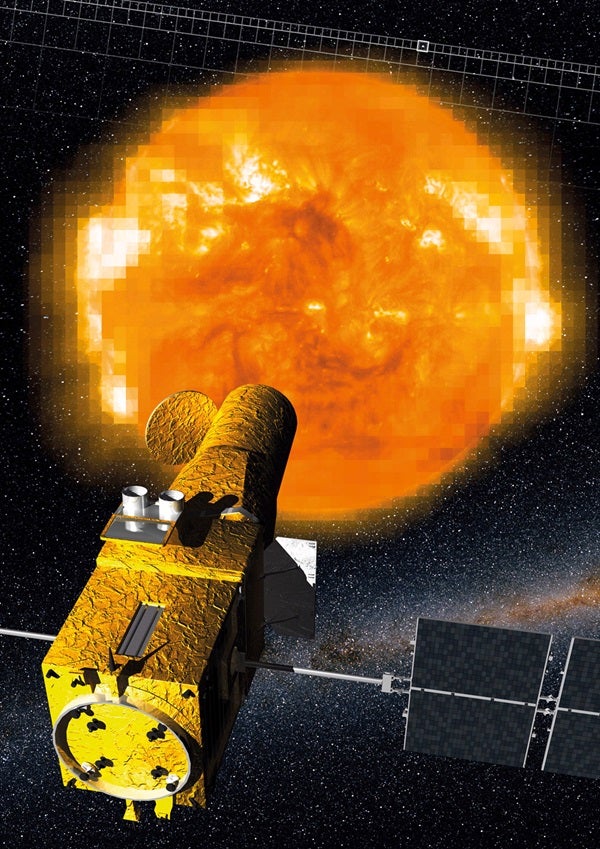In a bid to unlock longstanding mysteries of the Sun, including the impacts on Earth of its 11-year cycle, an international team of scientists has successfully probed a distant star. By monitoring the star’s sound waves, the team has observed a magnetic cycle analogous to the Sun’s solar cycle.
The scientists studied a star known as HD 49933, located 100 light-years from Earth in the constellation Monoceros the Unicorn. The team examined the star’s acoustic fluctuations, using a technique called “stellar seismology.” They detected the signature of “starspots,” areas of intense magnetic activity on the surface that are similar to sunspots. While scientists have previously observed these magnetic cycles in other stars, this was the first time they have discovered such a cycle using stellar
seismology.
“Essentially, the star is ringing like a bell,” said Travis Metcalfe from the National Center for Atmospheric Research (NCAR) in Boulder, Colorado. “As it moves through its starspot cycle, the tone and volume of the ringing changes in a very specific pattern, moving to higher tones with lower volume at the peak of its magnetic cycle.”
“We’ve discovered a magnetic activity cycle in this star similar to what we see with the Sun,” said Savita Mathur from NCAR. “This technique of listening to the stars will allow us to examine potentially hundreds of stars.”
The team hopes to assess the potential for other stars in our galaxy to host planets, including some perhaps capable of sustaining life.
“Understanding the activity of stars harboring planets is necessary because magnetic conditions on the star’s surface could influence the habitable zone, where life could develop,” said Rafael Garcia from CEA-Saclay in France.
Studying many stars with stellar seismology could help scientists better understand how magnetic activity cycles can differ from star to star, as well as the processes behind such cycles. The work could especially shed light on the magnetic processes that go on within the Sun, furthering our understanding of its influence on Earth’s climate. It may also lead to better predictions of the solar cycle and resulting geomagnetic storms that can cause major disruption to power grids and communication networks.
Classifying Stars
The scientists examined 187 days of data captured by the international Convection Rotation and Planetary Transits (CoRoT) space mission.
Launched December 27, 2006, CoRoT was developed and is operated by the French National Center for Space Studies (CNES) with contributions from Austria, Belgium, Brazil, Germany, Spain, and the European Space Agency. CoRoT is equipped with an 11-inch-diameter (27 centimeters) telescope and a 4-CCD camera sensitive to tiny variations in the light intensity from stars.
Scientists found that HD 49933 is much bigger and hotter than the Sun, and its magnetic cycle is much shorter. Whereas past surveys of stars have found cycles similar to the 11-year cycle of the Sun, this star has a cycle of less than a year.
This short cycle is important to scientists because it may enable them to observe an entire cycle more quickly, thereby gleaning more information about magnetic patterns than if they could only observe part of a longer cycle.
The scientists plan to expand their observations by using other stars observed by CoRoT as well as data from NASA’s Kepler mission. Kepler is seeking Earth-sized planets to survey. The mission will provide continuous data over 3 to 5 years from hundreds of stars that could be hosting planets.
“If it turns out that a short magnetic cycle is common in stars, then we will potentially observe a large number of full cycles during Kepler’s mission,” said Metcalfe. “The more stars and complete magnetic cycles we have to observe, the more we can place the Sun into context and explore the impacts of magnetic activity on possible planets hosted by these stars.”
The team has spent the past 6 months exploring the structure and dynamics of HD 49933 and classifying its size. They will next verify their observations using ground-based telescopes to confirm the magnetic activity of the star. When the star re-emerges from behind the Sun in September, they hope to measure the full length of the cycle. The CoRoT mission was designed to collect up to 150 days of continuous data at a time, which was not enough to determine the exact length of the star’s cycle.










